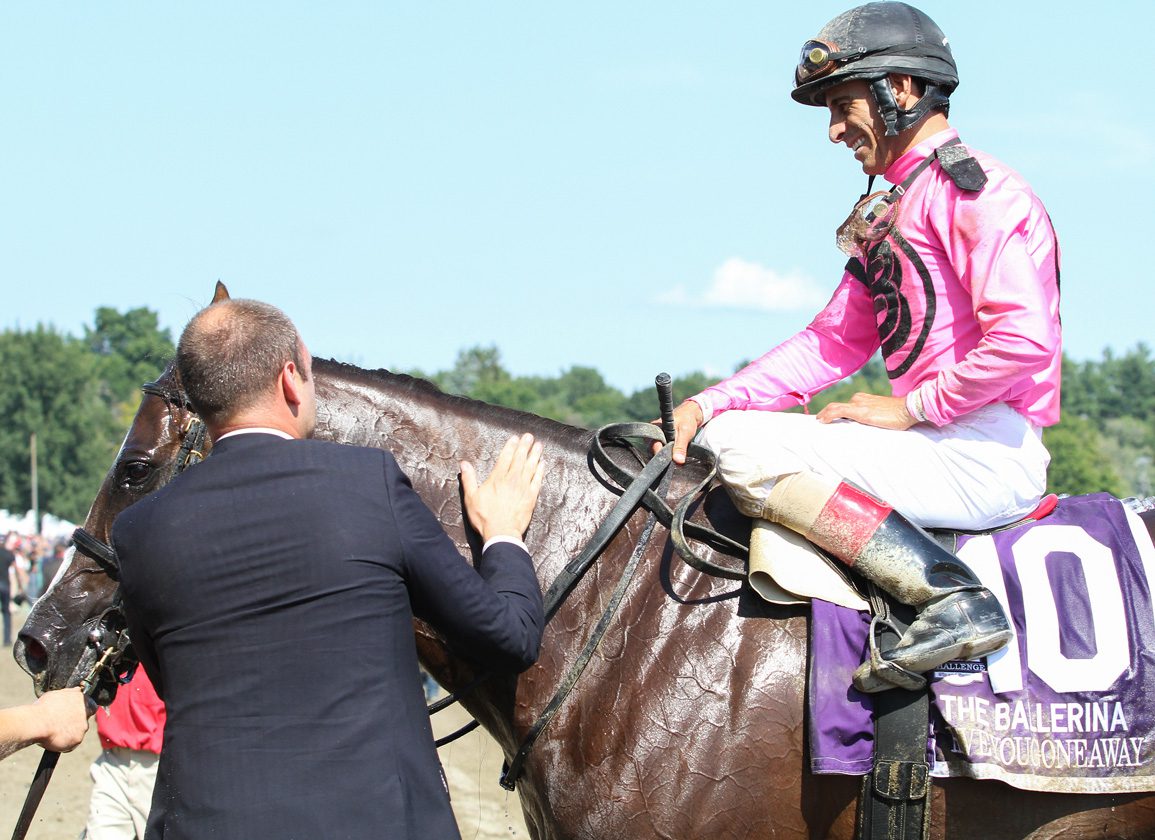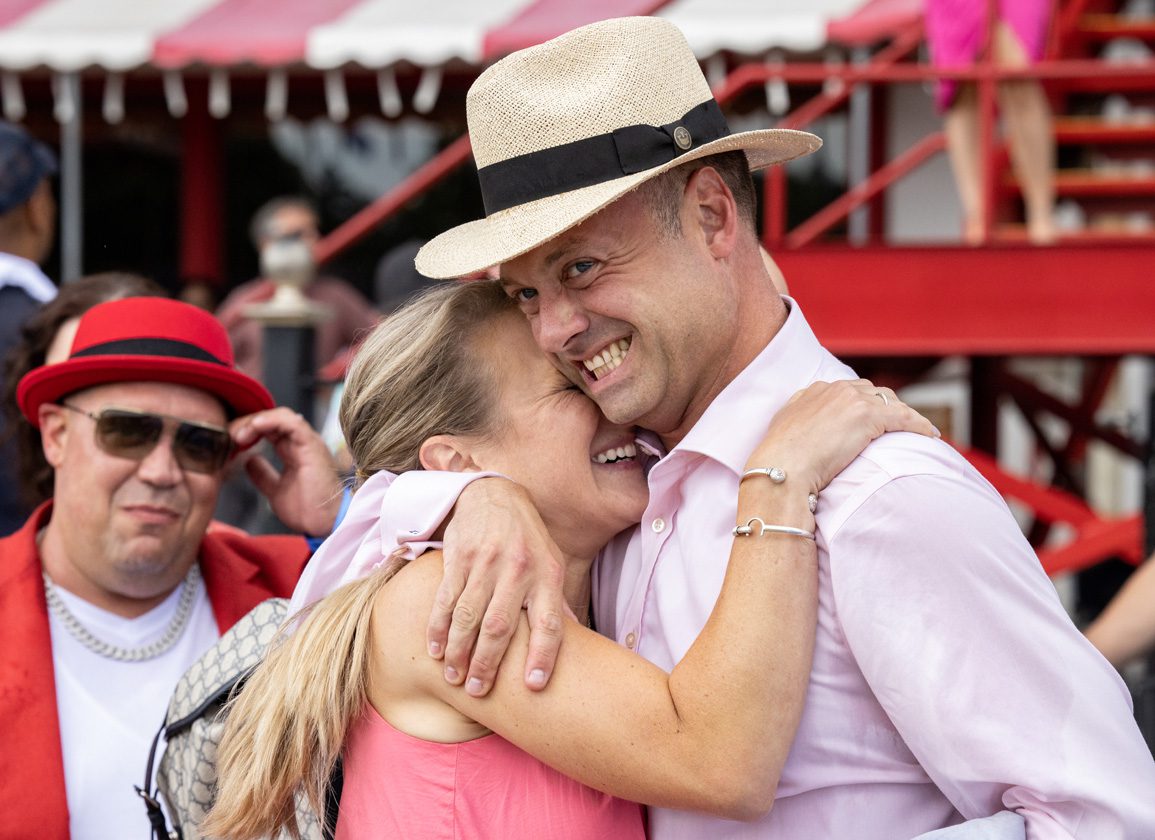Last year, we conducted a popular Q and A series called 'Smaller But Still Super,' where we featured veteran trainers who have built a competitive racing stable with relatively small numbers (click here to view the archive). This year, we will highlight trainers who have already cut their teeth as novice trainers, but now have a few years of experience under their belt and are looking to make a name for themselves as they grow their stable. We'll talk about the challenges that come with hanging out your single, advice for trainers setting out on their own, how the incoming class of young trainers differs from previous generations and more.
Tom Morley won his first race at Aqueduct in the spring of 2013 and has been a fixture on the New York circuit since.
Hailing from Yorkshire, the conditioner was born into a racing family. Not only was his father an owner and breeder, but his uncle David Morley was a Group I-winning trainer and his other uncle Christopher Spence was a senior steward at the Jockey Club in England. Among his cousins still involved in the sport, Henry Daly is a multiple Grade-I winning jump trainer.
Growing up, Morley spent his summer with David in Newmarket. Before graduating from Newcastle, he spent time as an assistant to Ed Dunlop at Gainsborough Stable and at the Lloyd Webber family's Watership Down Stud.
After graduating from the Godolphin Flying Start program, he worked as assistant to Jeremy Noseda for over four years. It was a busy time to be involved with Noseda's stable, with 14 Group I winners going through the barn while Morley was there including European champion sprinter Fleeting Spirit (Invincible Spirit {Ire}) and Breeders' Cup champion Wilko (Awesome Again).
From there, Morley made the move to the States to work for Eddie Kenneally, where he eventually helped open and develop Kenneally's New York operation.
As his stable celebrates its 10th anniversary this year, Morley has surpassed $13.5 million in career earnings. Graduates of his operation include Grade I victors Haveyougoneaway (Congrats) and Carrick (Giant's Causeway). Morley and his wife, NYRA racing analyst and Team Morley assistant/exercise rider Maggie Wolfendale Morley, have two daughters.

Morley celebrated his first career Grade I win with Haveyougoneaway in the 2016 GI Ballerina S. | Brittlan Wall
When you came to America, was the plan always to stay in the States and eventually train here?
Steve Hillen and Jeremy Noseda both suggested I come to America to get experience. A lot of trainers in the UK like John Gosden and Jeremy himself spent time here before going home.
That was the original game plan, but when I got here I felt like the American industry gave me the opportunity not only to travel, but also I felt like young people were given more of an opportunity to get going here. It's quite hard to get going in the UK. You have to have a lot of capital behind you. You need to be able to rent property and then you need to be able to fill the stalls immediately. Whereas here, you can literally start with one horse, a saddle and a bridle.
So after 18 months of being here, I pretty much made my mind up that I was going to stay. Now I have a business, a house, a wife and two children, so I'm not going anywhere.
Q: How has your stable evolved since it first opened?
We started with the one horse, Treblemaker (Read The Footnotes). Anthony Grey was very kind to send us a homebred of his. He won his second start on the 13th of April in 2013. I groomed and hotwalked the horse, and my girlfriend at the time who is now my wife rode him every morning.
It's grown from there over the years. Now in the middle of the summer we get up to about 50 horses. We'd love more and we're always looking for better-quality horses. That's part of growing into the training ranks. It's tough to attract the top-quality horses. I've always said that as a trainer starting out, the model should be to survive the first 10 years, grow the second 10 years and hopefully by the time you're getting into the third part of it, you're getting some top-quality horses.
When I started training in New York in 2013, seven people took their license out that year. I'm the only one that is still in business. That shows how tough it is as a young trainer to survive on a circuit like New York.
What is the biggest thing you have learned since going out on your own?
I think the biggest thing I've learned–and I'm still learning it–is to be patient with these horses. In this industry in America, we ask an awful lot of our young horses. I see a lot of talented horses not fulfill their potential because of an over-eagerness to get them to the races at a young age. I think if you can train for people who are willing to give them the time to mature, the horses will reward you in the long run. There is nothing better than having a really good 2-year-old, but just because a horse shows that he has an above-average level of ability, it doesn't mean that the right thing to do is try to win a maiden at Saratoga with him.
What do you think makes your stable and your training style unique?
It's very individual. Every horse does something different than what they did the day before.
We've certainly shown over the last few years that we can win races on both surfaces at every level. We've done very well getting older horses from other outfits and improving their careers. There are many facets to training horses and I think we're always trying to improve in every department as much as possible.

Tom and Maggie celebrate Dynadrive's win in the 2022 Fasig-Tipton Lure S. | Coglianese
Q: Do you think a trainer's success is defined more by their ability or by the quality of horses that they receive?
Without a doubt, it's about the quality of horses that they're receiving. There are plenty of very talented, capable horsemen out there. It's something that the American industry is really struggling with at the moment with super trainers. I take nothing away from these guys. It's not their fault that they train a vast number of horses. The reason they do is because they win the big races and they get the results. But I genuinely believe that there are plenty of trainers out there that could do just as good of a job with the number and quality of stock that those other trainers get. The industry needs to do more things, like this kind of series, to promote younger trainers.
If you aren't at the racetrack, what can you be found doing?
I have two daughters, Grace and Willow, who take up plenty of time. With Maggie doing her work for NYRA and Fox Sports, we're also both full-time parents as well. Between the children, our dogs and the retired racehorses, that seems to take up most of our free time but when we have the opportunity, we're a traveling family. The girls have plenty of stamps in their passports already.
With your hectic trainer's schedule and Maggie busy as one of the faces of America's Day at the Races, what is the juggling act like for you between your family and your stable?
It can be tough, especially in Saratoga when Maggie works enormously long hours. It can be tough on the girls as well because I have to be at the barn in the morning and the races in the afternoon. They go to Faith's House, which is an amazing Belmont Child Care Association school and playgroup. There's nothing I enjoy more than when I'm finished at the barn in the morning, to go pick them up and take them racing. They love going racing in Saratoga. I think it's mainly due to the popcorn and lemonade.
We try not to push horses on the girls at all because it would be very easy for them to be totally swamped with a father who trains and a mother who is incredibly active in the media. They do have a little pony called Snickers who they enjoy going to see, but it's nothing that we actively push upon them.
Obviously I'm enormously proud of my wife. She has become one of the very best around the world at what she does and she deserves all the applause that she gets because her results speak for themselves.
What is your favorite racetrack? I'm guessing Saratoga, but maybe not?
It's York, actually. I was born and raised in Yorkshire and the May and August meeting at York are two extremely special meetings for me. I really look forward to maybe one day having a horse run at York. It would be a homecoming for me.
I have a number of favorite tracks around the world. During the Flying Start program, I thought that Randwick was just the most spectacular place to go racing in Australia. There were always huge crowds of young, enthusiastic people.
I'm a huge jumps racing fan too. Maggie and I try to go to Cheltenham during the March festival whenever we can. There's no better racing atmosphere in my opinion anywhere on earth.
I do love going to Saratoga, but it's hard to call it my favorite because it is when we are under the most pressure. I don't think I can really enjoy it for what it is because it is such an important part of our year.
Who is your favorite horse that you've trained?
You never forget your first winner. I'll never forget the feeling of standing on the outside rail at Aqueduct as a field of maiden claiming $25,000 New York-breds were coming down the lane and Treblemaker cleared from the rest. He was in my barn for a while and then went on to Finger Lakes, but eventually came back to us as a pony for a while. He will always be special for us.
The first really good horse that I was lucky enough to train was Haveyougoneaway (Congrats). She seemed to really thrive in our program. She was my first stakes winner, my first graded stakes winner, my first Grade I winner and my first Breeders' Cup horse. At our house I have a photograph of her taken by Barbara Livingston from the day after the Ballerina. She was an extremely talented, very sweet filly. She will always hold a very special place in my heart.
Do you have any up-and-coming horses in your barn that we should know about?
I'm really looking forward to our group of 2-year-olds this year. We have an Arrogate colt that we bought at the Keeneland Sale for a lot of money coming to us. Steven Roco has bought an Upstart filly and an Into Mischief that are both training very well in Florida.
With the turf season coming up soon, it's going to be exciting to get some horses back like Dynadrive (Temple City), who won the Lure S. in Saratoga last year. His half-brother Tell Your Daddy (Scat Daddy), who won the GII Bernard Baruch H. in Saratoga the year before for us, is back breezing now in Florida. It's going to be fun having the brothers back here for turf season. I'm kind of dreading the idea that they might have to run against each other at some point. It would make an unbelievably cool story, but I'd like to try and keep them separate.
Click here for more from our 'Earning Their Stripes' series.

The post Earning Their Stripes: Tom Morley appeared first on TDN | Thoroughbred Daily News | Horse Racing News, Results and Video | Thoroughbred Breeding and Auctions.
Source of original post


